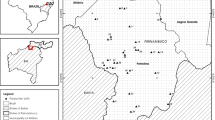Abstract
The current study examined the prevalence of Eimeria infections in domestic rabbits in China. A total of 480 faecal samples were collected from 48 farms in 14 provinces of China. Each faecal sample was subjected to oocyst counting and oocyst isolation. The Eimeria species from samples containing isolated and sporulated oocysts were morphologically identified under microscope. The overall prevalence of infections was 41.9% (201/480). Northwest China had the highest prevalence (70%), followed closely by Northeast China (65%) and Southwest China (62.5%). The prevalences in North China (34%) and South China (25.8%) were significantly lower. The large and medium farms had lower prevalences (34.2% and 37.2%, respectively) than the small farms (61.4%). Coccidian oocysts were found in 42.2% (76/180) of faecal samples from meat rabbits, 40% (28/70) from angora rabbits and 44.7% (85/190) from Rex rabbit. In total, ten species of Eimeria were identified from oocyst-positive samples. Concurrent infection with two to eight Eimeria species was found. E. perforans was the most prevalent species (35.2%), followed in order by E. media, E. magna, E. irresidua and E. intestinalis with prevalences of 31.3%, 28.8%, 19.4%, and 14.8%, respectively. Taken together, These results reveal the characteristics of the prevelance of rabbit coccidia infection in China, including the distribution, the scale of farming and the species, which are indispensable to the control of rabbits coccidiosis in China.


Similar content being viewed by others
References
Carvalho FS, Wenceslau AA, Teixeira M, Matos Carneiro JA, Melo AD, Albuquerque GR (2011) Diagnosis of Eimeria species using traditional and molecular methods in field studies. Vet Parasitol 176:95–100
Chen XN, Liao LF, Liu ZQ (1997) Prevalence of coccidia in rabbits in Guangxi. Chin J Vet Sci Technol 27:38–39, in Chinese
Coudert P (1989) Some peculiarities of rabbit coccidiosis. In: Yvoré, P (ed) Coccidia and coccidiomorphs, Vth International Coccidiosis Conference, Tours, France, 17–20 October. Les Colloques de l'INRA séries, vol. 49, INRA, Paris, pp 481–488
Coudert P, Licois D, Drouet-Viard F (1995) Eimeria species and strains of rabbit. In: Eckert J, Braun R, Shirley MW, Coudert P (eds) COST. 89/820. Biotechnology: guidelines on techniques in Coccidiosis Research. Office for Official Publications of the European Communities, Luxembourg, pp 52–73
Dalle Zotte A, Szendro Z (2011) The role of rabbit meat as functional food. Meat Sci 88:319–331
Kvicerova J, Pakandl M, Hypsa V (2008) Phylogenetic relationships among Eimeria spp. (Apicomplexa, Eimeriidae) infecting rabbits: evolutionary significance of biological and morphological features. Parasitology 135:443–452
Levecke B, Rinaldi L, Charlier J, Maurelli MP, Morgoglione ME, Vercruysse J, Cringoli G (2011) Monitoring drug efficacy against gastrointestinal nematodes when faecal egg counts are low: do the analytic sensitivity and the formula matter? Parasitol Res. 109(3):953–957
Li GQ, Lin HH, Fang ZH (1998) Investigation on coccidial species of rabbits in Guangdong. Chin J Rabbit Farming 3:19–21, in Chinese
Li YY (1999) Coccidiosis of rabbits and its control. Chin J Rabbit Farming 3:31–34, in Chinese
Licois D (2009) Comments on the article of Ming-Hsien Li and Hong-Kean Ooi “Fecal occult blood manifestation of intestinal Eimeria spp. infection in rabbit” [Vet. Parasitol. 161 (2009) 327–329]. Vet Parasitol 164:363–364, author reply 365–366
Licois P, Coudert P (1982) Coccidioses et diarrhées du lapin à l'engraissement. Bull GTV 5:109–122
Meng QL, Tian GF, Yan HB, Zhang DF (2007) Investigation on coccidial species of rabbits in Xinjiang. Progr Vet Med 28:44–47, in Chinese
Mundt HC, Bangoura B, Mengel H, Keidel J, Daugschies A (2005) Control of clinical coccidiosis of calves due to Eimeria bovis and Eimeria zuernii with toltrazuril under field conditions. Parasitol Res 97(Suppl 1):S134–142
Pakandl M, Hlaskova L, Poplstein M, Chroma V, Vodicka T, Salat J, Mucksova J (2008) Dependence of the immune response to coccidiosis on the age of rabbit suckling. Parasitol Res 103:1265–1271
Pakandl M (2009) Coccidia of rabbit: a review. Folia Parasitol 56:153–166
Pan BL, Zhang YF, Suo X, Xue Y (2008) Effect of subcutaneously administered diclazuril on the output of Eimeria species oocysts by experimentally infected rabbits. Vet Rec 162:153–155
Polozowski A (1993) Coccidiosis of rabbits and its control. Wiadomosci Parazytologiczne 39:13–28
Varga I (1982) Large-scale management systems and parasite populations: coccidia in rabbits. Vet Parasitol 11:69–84
Velkers FC, Blake DP, Graat EA, Vernooij JC, Bouma A, de Jong MC, Stegeman JA (2010) Quantification of Eimeria acervulina in faeces of broilers: comparison of McMaster oocyst counts from 24 h faecal collections and single droppings to real-time PCR from cloacal swabs. Vet Parasitol 169:1–7
Zhao YP, Wu SQ, Mu XM, Tang CM, Wei D (2008) A preliminary investigation of the coccidios is lepus infection in Zhangjiakou area. Chin J Rabbit Farming 3:33–34, in Chinese
Acknowledgements
We thank Associate Professor Sufang Fang from Hebei North University for her technical guidance on the morphological verification of oocysts. This study was supported by the earmarked fund for Modern Agro-industry Technology Research System (CARS-44).
Author information
Authors and Affiliations
Corresponding author
Additional information
Fa Jing and Guangwen Yin contributed equally to this work.
Rights and permissions
About this article
Cite this article
Jing, F., Yin, G., Liu, X. et al. Large-scale survey of the prevalence of Eimeria infections in domestic rabbits in China. Parasitol Res 110, 1495–1500 (2012). https://doi.org/10.1007/s00436-011-2653-4
Received:
Accepted:
Published:
Issue Date:
DOI: https://doi.org/10.1007/s00436-011-2653-4




